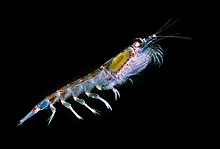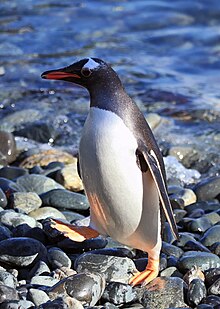User:Annchristinehedstrom/sandbox
Ecological effects of climate change
[edit]Plants
[edit]The continental flora in Antarctica is dominated by lichens, followed by mosses and algae. The plants are mainly found in coastal areas in Antarctica. The only vascular plants, Deschampsia antarctica and Colobanthus quitensis, are found on the Antarctic Peninsula. Because of changing climatic conditions, adaptation to the new conditions is necessary for the survival of the plants.[1] One way to deal with the problem is to perform fast growth when the conditions are favourable. High concentrations of carbon dioxide and other greenhouse gases in the atmosphere cause climate change with increase in temperature, which leads to (I) increase in water availability, which in turn leads to (II) increase in plant colonization and (III) local-scale population expansion, which leads to (IV) increase in biomass, trophic complexity, and increased terrestrial diversity, and (V) more complex ecosystem structure, and (VI) dominance of biotic factors that drive processes in the ecosystem.

Increased photosynthesis because of elevated temperatures has been shown in two maritime vascular species (Deschampsia antarctica and Colobanthus quitensis).[2] Because of increased temperature, the two vascular plants have increased in population size and in their expansion range. Climate change may also have significant effects on indirect processes, for example soil nutrient availability, plant nutrient uptake, and metabolism.
Increased photosynthesis has also been found in the three continental mosses Bryum argenteum, Bryum pseudotriquetrum, and Ceratodon purpureus.[3] A drying trend is affecting terrestrial biota in East Antarctica. Drier microclimates have led to reduction in moss health.[3] Because of acute stress, the moss colour has changed. Due to drought and other stressors, many green mosses have turned to red to brown coloration. This indicates a shift away from photosynthesis and growth towards investments in photoprotective pigments. If the environmental conditions improve, the mosses can recover.[3] If photoprotective pigments decline relative to chlorophyll, the stressed mosses will be green again. New healthy moss plants can sprout through moribund turf. At the expense of the endemic species Schistidium antarctici, two desiccation tolerant moss species, Bryum pseudotriquetrum and Ceratodon purpureus, have increased.
Significant changes that affect the lichen biota take place on young moraines in the proximity of recently uncovered areas because of retreat of glaciers.[4] The changes in diversity of lichens depend on the humidity of the substrate and on the duration of the snow cover. Habitats that reduce the frequency of occurrence are wet or moist stony soil, rock ledges, moist mosses, and meltwater runnels. Continuous deglaciation has resulted in increased colonization by pioneer lichen species. In the maritime cliff rocks and in the proximity of large penguin colonies, the smallest changes in the lichen biota have been observed.
Increase in UV-B radiation because of thinner ozone layer causes damage to cells and photosynthesis. Plants try to defend themselves against increase in ultraviolet radiation with the help of antioxidants.[5] In UV-B exposed plants, the antioxidative enzymes superoxide dismutase, catalase, and peroxidase are synthesized. The exposed plants also synthesize the non-enzymatic antioxidants ascorbate, carotenoids, and flavonoids. All these antioxidants are also used by humans to protect themselves from the damaging effects by free radicals and reactive oxygen species. Uncertainty of the changing environmental conditions causes difficulties in adaptation and survival for species in Antarctica.[1] Increase in temperature might lead to invasion of alien species and disruptions of the ecological balance in the Antarctic ecosystem. Increasing UV-B radiation already has a negative impact on Antarctic flora.[1] In future applied ecology and biochemical pathways must adapt better for the species in Antarctica.
Animals

The marine food web in Antarctica is characterized by few trophic components and low prey diversity. The predator-prey dynamics depend on fluctuations in the relative short food chains. A few key species dominate the marine ecosystems. Antarctic krill (Euphasia superba) and ice krill (Euphasia crystallorophias) are examples of key species.[6] They feed on phytoplankton and are the main food for fish and penguins. Shifts in the periodicity of sea ice cycles because of climate change cause mismatches between earlier phytoplankton blooms, krill development, and availability for penguins.[7] The consequences for many penguins are increase in foraging trips and reduced breeding success. Absence of krill leads to increased population fluctuations and diet switches for penguins.
As penguins are highest in the Antarctic food web, they will be severely affected by climate change, but they will respond by adaptation or by range shifts.[8] Adaptation acts via phenotypic plasticity. Range shift is another way to deal with climate change.[9] Dispersal leads to local extinction and colonization elsewhere, where adaptation can prevent extinction. Microevolution is difficult to find for climate change because it is too slow. The most important responses to climate change in Antarctica are poleward shifts, expansion, and range contraction.[7] Ice-obligate penguins are the most affected species, but the near threatened and ice-intolerant gentoo penguin (Pygoscelis papua) has been benefitted.[10] In maritime Antarctica the population of gentoo penguins is rapidly increasing. Due to regional climate changes, they have moved southwards. Now they colonise previously inaccessible territories. Gentoo penguins use mosses as nesting material. This nesting behaviour is new for southern penguin colonies in Antarctica. By dispersal and adaptive nesting behavour, gentoo penguins have been remarkably successful in population growth. At the borders of the current geographic distributions, the most obvious responses to climate change occur. There the most likely response to climate change is range shift because adaptation and evolution in penguins are too slow.

In birds phenological responses are commonly observed, for example shifts in return to breeding places and timing of egg laying.[11] For penguins shift in penguin phenology in response to prey phenology is important. Often common environmental drivers determine the predator-prey synchrony.[12] Climate driven fluctuations that reduce krill availability also reduce the penguin breeding success. Although gentoo penguins share their prey resource with Adélie penguins (Pygoscelis adeliae) during the breeding season, there is no resource competition between the two species.[9] This implies that current population trends in this region are governed by other factors than competition. The emperor penguin (Aptenodytes forsteri), which has a long breeding season, is constrained in space and time. In the future phenological changes in penguins are likely to be limited by their genotypes. Possible ecological traps might attract ice-intolerant species to ice-free areas without foraging grounds.[13] In the future fitness will decrease if there are no favourable conditions for life cycle events and no adaptive response.
- ^ a b c Singh, Jaswant; Singh, Rudra P.; Khare, Rajni (2018-12). "Influence of climate change on Antarctic flora". Polar Science. 18: 94–101. doi:10.1016/j.polar.2018.05.006.
{{cite journal}}: Check date values in:|date=(help) - ^ Cavieres, Lohengrin A.; Sáez, Patricia; Sanhueza, Carolina; Sierra-Almeida, Angela; Rabert, Claudia; Corcuera, Luis J.; Alberdi, Miren; Bravo, León A. (2016-03). "Ecophysiological traits of Antarctic vascular plants: their importance in the responses to climate change". Plant Ecology. 217 (3): 343–358. doi:10.1007/s11258-016-0585-x. ISSN 1385-0237.
{{cite journal}}: Check date values in:|date=(help) - ^ a b c Robinson, Sharon A.; King, Diana H.; Bramley-Alves, Jessica; Waterman, Melinda J.; Ashcroft, Michael B.; Wasley, Jane; Turnbull, Johanna D.; Miller, Rebecca E.; Ryan-Colton, Ellen; Benny, Taylor; Mullany, Kathryn (2018-10). "Rapid change in East Antarctic terrestrial vegetation in response to regional drying". Nature Climate Change. 8 (10): 879–884. doi:10.1038/s41558-018-0280-0. ISSN 1758-678X.
{{cite journal}}: Check date values in:|date=(help) - ^ Olech, Maria; Słaby, Agnieszka (2016-08). "Changes in the lichen biota of the Lions Rump area, King George Island, Antarctica, over the last 20 years". Polar Biology. 39 (8): 1499–1503. doi:10.1007/s00300-015-1863-0. ISSN 0722-4060.
{{cite journal}}: Check date values in:|date=(help) - ^ Winkel-Shirley, Brenda (2002-06). "Biosynthesis of flavonoids and effects of stress". Current Opinion in Plant Biology. 5 (3): 218–223. doi:10.1016/S1369-5266(02)00256-X.
{{cite journal}}: Check date values in:|date=(help) - ^ Smetacek, Victor; Nicol, Stephen (2005-09). "Polar ocean ecosystems in a changing world". Nature. 437 (7057): 362–368. doi:10.1038/nature04161. ISSN 0028-0836.
{{cite journal}}: Check date values in:|date=(help) - ^ a b Hinke, Jefferson T.; Salwicka, Kasia; Trivelpiece, Susan G.; Watters, George M.; Trivelpiece, Wayne Z. (2007-09-10). "Divergent responses of Pygoscelis penguins reveal a common environmental driver". Oecologia. 153 (4): 845–855. doi:10.1007/s00442-007-0781-4. ISSN 0029-8549.
- ^ Davis, Margaret B.; Shaw, Ruth G.; Etterson, Julie R. (2005-07). "EVOLUTIONARY RESPONSES TO CHANGING CLIMATE". Ecology. 86 (7): 1704–1714. doi:10.1890/03-0788. ISSN 0012-9658.
{{cite journal}}: Check date values in:|date=(help) - ^ a b Pickett, Erin P.; Fraser, William R.; Patterson‐Fraser, Donna L.; Cimino, Megan A.; Torres, Leigh G.; Friedlaender, Ari S. (2018-10). "Spatial niche partitioning may promote coexistence of Pygoscelis penguins as climate‐induced sympatry occurs". Ecology and Evolution. 8 (19): 9764–9778. doi:10.1002/ece3.4445. ISSN 2045-7758. PMC 6202752. PMID 30386573.
{{cite journal}}: Check date values in:|date=(help)CS1 maint: PMC format (link) - ^ Dykyy, Ihor; Bedernichek, Tymur (2022-01). "Gentoo Penguins (Pygoscelis papua) started using mosses as nesting material in the southernmost colony on the Antarctic Peninsula (Cape Tuxen, Graham Land)". Polar Biology. 45 (1): 149–152. doi:10.1007/s00300-021-02968-4. ISSN 0722-4060.
{{cite journal}}: Check date values in:|date=(help) - ^ Visser, Marcel E.; Both, Christiaan; Lambrechts, Marcel M. (2004), "Global Climate Change Leads to Mistimed Avian Reproduction", Advances in Ecological Research, vol. 35, Elsevier, pp. 89–110, doi:10.1016/s0065-2504(04)35005-1, ISBN 978-0-12-013935-4, retrieved 2022-05-14
- ^ Hinke, Jefferson T.; Salwicka, Kasia; Trivelpiece, Susan G.; Watters, George M.; Trivelpiece, Wayne Z. (2007-09-10). "Divergent responses of Pygoscelis penguins reveal a common environmental driver". Oecologia. 153 (4): 845–855. doi:10.1007/s00442-007-0781-4. ISSN 0029-8549.
- ^ Forcada, Jaume; Trathan, Philip N. (2009-07). "Penguin responses to climate change in the Southern Ocean". Global Change Biology. 15 (7): 1618–1630. doi:10.1111/j.1365-2486.2009.01909.x.
{{cite journal}}: Check date values in:|date=(help)
